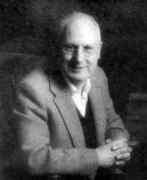◀ ▲ ▶History / 20th-century / Person: Cassels (2), John William Scott
Person: Cassels (2), John William Scott

Ian Cassels was an English mathematician who worked on the geometry of numbers, diophantine approximation and the arithmetic of elliptic curves.
Mathematical Profile (Excerpt):
- His parents were John William Cassels, Director of Agriculture in County Durham in the north of England, and Muriel Speakman Lojoit.
- He attended Neville's Cross Council School in Durham and from there he went to George Heriot's School in Edinburgh where he completed his schooling.
- He then entered Edinburgh University, graduating with an M.A. in 1943.
- From about July 1943, shortly after graduating, until after VJ day in 1945 he worked in the Naval Section of the Government Code and Cypher School at Bletchley Park.
- He was a 'TJAO' (temporary junior assistant officer, which was equivalent to the most junior commissioned rank in the armed forces).
- JN 25 was an enciphered code, in which 5-figure code groups were enciphered by adding 5-figure random 'additives' (modulo 10).
- To do so they partly relied on established 'good groups' : code groups known to be in the codebook because they had appeared previously.
- Simpson's team had to determine how one speculative additive rated against another.
- Cassels worked with Simpson and Jimmy Whitworth, another mathematician.
- They adopted applied Bayes' Theorem, when it was definitely unorthodox to do so, to combine the weights of the evidence that each speculative codegroup provided, then used logarithms to allow addition and finally rounded the logarithms to two-digit scores which could be added easily by unskilled staff.
- In this year he was elected a fellow of Trinity College.
- Constance Cassels died in 2000.
- After one year as a lecturer in mathematics at the University of Manchester Cassels returned to Cambridge in 1950 as a lecturer.
- In 1963 he was appointed Reader in Arithmetic at Cambridge and in the same year he was honoured with election as a fellow of the Royal Society of London.
- Then, in 1967, he was appointed Sadleirian Professor of Pure Mathematics at Cambridge.
- Two years later, in 1969, he became Head of the Department of Pure Mathematics and Mathematical Statistics at Cambridge and he continued as Sadleirian Professor and Head of Department until he retired in 1984.
- Cassels served the Royal Society and the London Mathematical Society in various roles.
- He was a member of the Council of the Royal Society in 1970-71 and he served as vice-president in 1974-78.
- He was the 58th president of the London Mathematical Society in 1976-78 and he was a member of the Executive of the International Mathematical Union from 1978 to 1982.
- Cassels has worked on every aspect of the theory of numbers, particularly on the theory of rational quadratic forms and local fields.
- His mathematical publications started in about 1947 with a series of papers on the geometry of numbers, in particular papers on theorems of Khinchin and of Davenport, and on a problem of Mahler.
- After further papers on Diophantine equations and Diophantine approximation he wrote a series of five papers on Some metrical theorems in Diophantine approximation.
- He next worked on Vinogradov's theorem on uniform distribution and, in 1957, he published his first book Introduction to Diophantine approximation (1957) which was reprinted in 1972.
- After further papers on subgroups of infinite abelian groups and normal numbers he wrote a series of eight papers on Arithmetic on curves of genus 1.
- Then in 1959 he published another book, An introduction to the geometry of numbers.
- Among work undertaken after this was work on the representation of rational functions as sums of squares, integral points on certain elliptic curves, Kummer sums, and on factorising polynomials in several variables.
- Cassels has won received a number of awards for his outstanding contributions.
- for his numerous important contributions to the theory of numbers.
- He also received the De Morgan Medal from the London Mathematical Society in 1986.
- These papers remain fundamental to our understanding of the problems involved and have provided the foundation for much subsequent work.
- Ian Cassels has contributed to almost all branches of number theory.
- His work includes numerous papers on Diophantine Approximation and the Geometry of Numbers, and seminal contributions to the theory of quadratic forms and sums of squares.
- He has written excellent books on Diophantine Approximation, Geometry of Numbers, Algebraic Number Theory and Rational Quadratic Forms.
- He lists his leisure interests as The Higher Arithmetic and gardening.
Born 11 July 1922, Durham, England. Died 27 July 2015, Cambridge, England.
View full biography at MacTutor
Tags relevant for this person:
Origin England
Thank you to the contributors under CC BY-SA 4.0! 

- Github:
-

- non-Github:
- @J-J-O'Connor
- @E-F-Robertson
References
Adapted from other CC BY-SA 4.0 Sources:
- O’Connor, John J; Robertson, Edmund F: MacTutor History of Mathematics Archive
